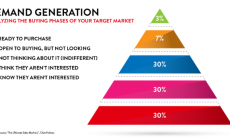Succeeding at marketing these days really isn’t that hard. Oh, don’t get me wrong, it takes some effort, along with time, money, and resources. But most marketing plans follow a fairly straightforward path that depends on developing high-quality content and getting that content in front of customers on mobile, search, and social channels. Sure, other avenues exist (and are well-worth exploring for your brand and business). But, I challenge you to find a marketing plan that doesn’t include content, mobile, social, and search among its core components.
So, if we all know how we’re planning to reach customers, why is it so difficult to actually do it?
Good question. The reason many brands struggle in this approach is because they haven’t asked a few simple, but very important, questions. Or, more often, haven’t spent near enough effort answering.
What questions are those? Well, I’m glad you asked. Here you go:
- Who is your customer, really?
- What is it your customer actually needs?
Sounds simple, right? Well, before you go running off, take a moment to really think through those questions. Because this is an area where the devil quite literally lives in the details. Answering who your customer really is, and what really matters in their lives; takes time, effort, and attention. One of the reasons we’re always preaching about data-driven marketing around here is because that data provides you insights into—and ongoing information about the accuracy of—your answers.
How much do you really know about your customers? What matters to them? How are they finding solutions to their needs? What’s the actual problem they’re trying to solve in their lives every day? Where are they looking? When do they need it? Why do they care? Remember, no one’s looking for your product, really. They’re looking to solve some problem in their lives. As the old joke goes, nobody wants a drill; they want a hole.
Your customers’ near-constant thirst for the right information–the best solution for their needs–is really what’s driving the strong relationship between content marketing, mobile, search, and social. Content, mobile, search, and social comprise the core tools your customers use to accomplish their goals every day. Or, to paraphrase that old joke, your customers don’t want a smartphone; they want to remain connected to the information and people important to their lives. Their phone—and the social networks and search engines typically used on mobile devices—simply represents the current state of the art for making that happen. It seems likely that wearables and the Internet of Things will take over some or all of those duties over time. But at least for now it’s all about mobile. And social. And search. And, fundamentally, the content that answers their questions.
Think about it. Sophisticated algorithms control what your customers see and when they see it. Social networks, such as Facebook and Twitter, use algorithms to filter and present the right information based on what they believe their users—your customers—really want to see. Google and Bing use algorithms to determine which page or app best answers the questions their users—again, your customers—ask. And, increasingly, those algorithms—such as used by Google Now or Apple’s Siri—attempt to answer questions before anyone’s even thought to ask them, anticipating customer needs and offering solutions to their problems before they’ve even had a chance to come up.
Ultimately, if you want your customers to find you—your products and services—to choose you, and to use you, you’ve got to answer their questions. To do that, you’ve really got to focus on answering your own questions about who your customers really are and what they really need. No search engine will present you as an option if you don’t. No friend or family member will share how their life was improved by your offering. As a result, you’ll receive no links, nor likes, little traffic, and limited success.
I don’t know about you, but that doesn’t sound like much fun. At all.
The better a job you do understanding your customer—who they are, what they truly want and need, what that matters, and where, when, and how they’re planning to solve their problem—the better a position you place yourself in to craft the content your customers need and to help them answer their questions. Oh, and to choose you as the solution to their problem.
So, really, the next important questions you should be asking are, “What in the world are we waiting for?” and “How soon can we start?”




